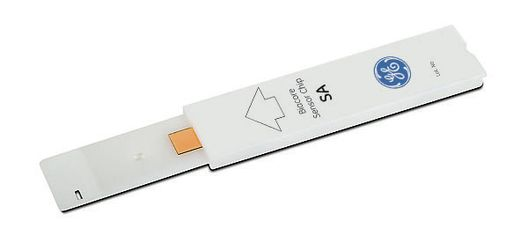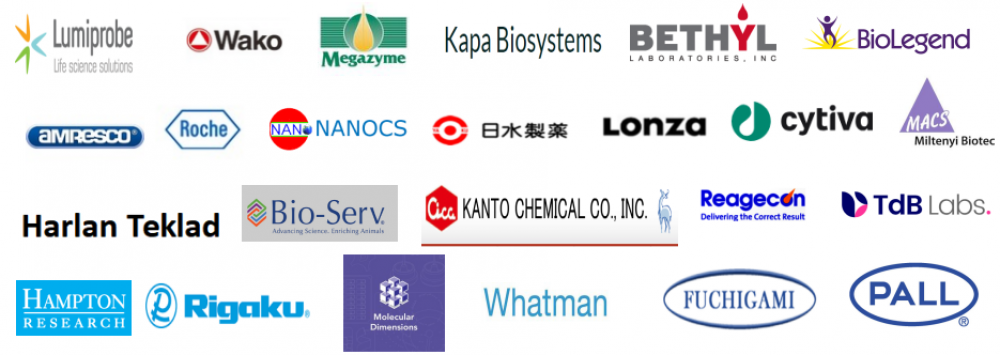GE Series S Sensor Chip SA,Biacore,芯片,相互作用
货号:BR100531
规格: 无
计量单位:盒
品牌:BIACORE
1.概述
Sensor Chip SAThis high-affinity streptavidin (SA) sensor chip immobilizes biotinylated molecules for surface plasmon resonance (SPR) interaction analysis on Biacore systems. Versatile: immobilizes biotinylated peptides, proteins, nucleic acids, or carbohydrates Ready-to-use: streptavidin is pre-immobilized, ready for fast, high-affinity ligand capture Robust: streptavidin-biotin is one of the strongest non-covalent interactions in nature Non-covalent: a convenient alternative for ligands refractory to covalent immobilization Standardized ligand orientation: controlled biotinylation enables oriented capture Streptavidin-biotin capture Sensor Chip SA provides a surface of streptavidin covalently attached to a carboxymethyldextran matrix.
Dissociation of biotinylated ligands from the surface of the chip is generally negligible during the course of a Biacore analysis because the affinity of streptavidin for biotin is extremely high, with an equilibrium dissociation constant of about 10-15 M. High binding capacity, reproducibility, and chemical resistance give excellent performance over a broad range of applications.
The surface of Sensor Chip SA is resistant to 1-minute pulses of many agents commonly used in SPR sensor chip washing and regeneration protocols (Table 1). Agent Concentration Acetonitrile 30% DMSO 10% DTE 0.1 M EDTA 0.35 M Ethanol 70% Ethanolamine 1 M Ethynel glycol 100% Formamide 40% Formic acid 20% Glycine pH 1.5 to 3.0 100 mM HCI 100 mM Imidazole 300 mM MgCI2 4 M NaOH 100 mM NaCI 5 M SDS 0.5% Surfactant P20 5% Urea 8 M Table 1.
Common agents compatible with Sensor Chip SA (see also Instruction 22-0564-88 AD) Biacore Sensor Chip SA applications Biotin has become a popular molecular tag for capture and interaction studies because it is stable and rarely interferes with target activity or structure due to its small size.
Biotin can be conveniently conjugated to a wide range of target molecules by chemical or enzymatic means. Applications for Sensor Chip SA are therefore broad. Examples include: capture of intact liposomes for protein-membrane interaction studies screening of endocrine-disrupting chemicals elucidating DNA- and RNA- mediated mechanisms of catechins in cancer prevention Sensor chip formats for Biacore systems Biacore sensor chips are available in two formats: “S series” sensor chips are for use with Biacore 8K+, Biacore 8K, Biacore S200, Biacore T200, and Biacore 4000 SPR systems.
Sensor chips not designated with “S series” are designed for Biacore X100, Biacore 3000 and Biacore C SPR systems. This high-affinity streptavidin (SA) sensor chip immobilizes biotinylated molecules for SPR interaction analysis on Biacore systems.

1.概述
传感器芯片 SA 这种高亲和力链霉亲和素 (SA) 传感器芯片固定生物素化分子,用于在 Biacore 系统上进行表面等离子体共振 (SPR) 相互作用分析。多功能:固定生物素化肽、蛋白质、核酸或碳水化合物 即用型:链霉亲和素已预先固定,可用于快速、高亲和力的配体捕获 稳健:链霉亲和素-生物素是自然界中最强的非共价相互作用之一非共价:可方便地替代共价固定化难治的配体 标准化配体定向:受控生物素化可实现定向捕获 链霉亲和素-生物素捕获传感器芯片 SA 提供共价连接至羧甲基葡聚糖基质的链霉亲和素表面。
在 Biacore 分析过程中,生物素化配体从芯片表面的解离通常可以忽略不计,因为链霉亲和素对生物素的亲和力非常高,平衡解离常数约为 10-15 M。耐化学性在广泛的应用范围内提供卓越的性能。
传感器芯片 SA 的表面可耐受 SPR 传感器芯片清洗和再生方案中常用的许多试剂的 1 分钟脉冲(表 1)。试剂浓度 乙腈 30% DMSO 10% DTE 0.1 M EDTA 0.35 M 乙醇 70% 乙醇胺 1 M 乙二醇 100% 甲酰胺 40% 甲酸 20% 甘氨酸 pH 1.5 至 3.0 100 mM HCl I0 mM Mg 10 mM Mg 10 mM NaOH 100 mM NaCl 5 M SDS 0.5% 表面活性剂 P20 5% 尿素 8 M 表 1。
与传感器芯片 SA 兼容的常用试剂(另请参见说明 22-0564-88 AD) Biacore 传感器芯片 SA 应用 生物素已成为捕获和相互作用研究的流行分子标签,因为它稳定且很少干扰目标活性或结构,因为它具有小尺寸。
生物素可以通过化学或酶促方法方便地与范围广泛的目标分子结合。因此,传感器芯片 SA 的应用范围很广。示例包括: 捕获完整脂质体用于蛋白质-膜相互作用研究 筛选干扰内分泌的化学物质 阐明 DNA 和 RNA 介导的儿茶素在癌症预防中的机制 Biacore 系统的传感器芯片格式 Biacore 传感器芯片有两种格式:“S 系列”传感器芯片用于 Biacore 8K+、Biacore 8K、Biacore S200、Biacore T200 和 Biacore 4000 SPR 系统。
未标明“S 系列”的传感器芯片专为 Biacore X100、Biacore 3000 和 Biacore C SPR 系统设计。这种高亲和力链霉亲和素 (SA) 传感器芯片固定生物素化分子,用于在 Biacore 系统上进行 SPR 相互作用分析。

